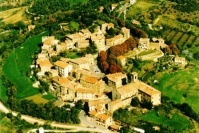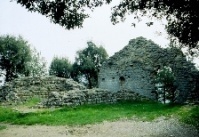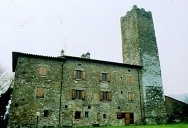Umbertide - Preggio
 Per la strada che porta a Preggio, su una collina che domina Umbertide, sorge il castello di Romeggio, costruzione che risalirebbe al periodo medioevale, quando per queste contrade transitavano i “Romei”, pellegrini che si recavano a visitare i luoghi santi. A breve distanza si incontra il castello di Polgeto, costruito nel 1399 intorno ad un fortino già esistente nel XIIsecolo che apparteneva a Biagio di Buto, fuoruscito perugino. E’ uno dei castelli meglio conservati, perchè è stato sempre abitato. Proseguendo poi per alcuni chilometri si arriva a Preggio, antico borgo a 638 m. di altezza circondato da una ricca vegetazione e da boschi che ne fanno un luogo di villeggiatura per chi ama un ambiente naturale incontaminato e la quiete della collina umbra.La Rocca di Preggio, per la sua posizione dominante, era considerata tra le più importanti del territorio Perugino e dell’Alta valle del Tevere. Esisteva già nel 917, anno in cui l’imperatore Berengario I confermò la signoria di Preggio al marchese Uguccione II dei Bourbon. Oltre ai resti della rocca sono da vedere la chiesa della S.S. Trinità in San Francesco (1223) che conserva un reliquario d’argento dorato che custodisce una “Sacra Spina” esposta il martedì di Pasqua e la chiesa della Madonna delle Grazie
Per la strada che porta a Preggio, su una collina che domina Umbertide, sorge il castello di Romeggio, costruzione che risalirebbe al periodo medioevale, quando per queste contrade transitavano i “Romei”, pellegrini che si recavano a visitare i luoghi santi. A breve distanza si incontra il castello di Polgeto, costruito nel 1399 intorno ad un fortino già esistente nel XIIsecolo che apparteneva a Biagio di Buto, fuoruscito perugino. E’ uno dei castelli meglio conservati, perchè è stato sempre abitato. Proseguendo poi per alcuni chilometri si arriva a Preggio, antico borgo a 638 m. di altezza circondato da una ricca vegetazione e da boschi che ne fanno un luogo di villeggiatura per chi ama un ambiente naturale incontaminato e la quiete della collina umbra.La Rocca di Preggio, per la sua posizione dominante, era considerata tra le più importanti del territorio Perugino e dell’Alta valle del Tevere. Esisteva già nel 917, anno in cui l’imperatore Berengario I confermò la signoria di Preggio al marchese Uguccione II dei Bourbon. Oltre ai resti della rocca sono da vedere la chiesa della S.S. Trinità in San Francesco (1223) che conserva un reliquario d’argento dorato che custodisce una “Sacra Spina” esposta il martedì di Pasqua e la chiesa della Madonna delle Grazie
* * *
Following the road leading to Preggio, on a gentle hill overlooking Umbertide, rises the Romeggio Castle. It probably dates back to the Middle Ages when the so-called “Romei” (this was the name given to pilgrims who used to visit holy places) were following these routes. The nearby Polgeto Castle was built in 1399 all around a small XII century fortress, once owned by Biagio di Buto, a political exile who left Perugia. It is one of the best preserved castles as it has been always inhabited. Few kilometers further, Preggio, a small village 638 mt. above sea level, with its lush vegetation and woods, is the ideal place for those tourists who want to enjoy the peace and unspoilt environment of Umbria gentle hills. The Rocca of Preggio, with its dominat position, was considered one of the most important fortresses in the territory of Perugia and the Upper Tiber Valley. It dates back to 917, when Emperor Berengario I granted Uguccione II dei Bourbon the title of Signore di Preggio. Besides the ruins of the fortress the Church of the Madonna delle Grazie and the Church of the Holy Trinity in San Francesco (1223) are worth visiting. The latter is home to a precious silver shrine which keeps a “Holy Thorn”, put on display on Easter Tuesday.
 Per conoscere le iniziative di Preggio
Per conoscere le iniziative di Preggio  consulta "Preggio News", il notiziario della locale Pro Loco.
consulta "Preggio News", il notiziario della locale Pro Loco.
To learn about the initiatives of Preggio see "Preggio News", the newsletter of the Pro Loco.
Preggio News n.1 (996kB - PDF)
Preggio News n.2 (190kB - PDF)
Preggio News n.3 (835kB - PDF)
Preggio News n.4 (1.594kB - PDF)
Preggio News n.1 - 2014 (808kB - PDF)
Preggio News n.2 - 2014 (1.595kB - PDF)
Preggio News n. 3 - 2014 (1.594kB - PDF)
